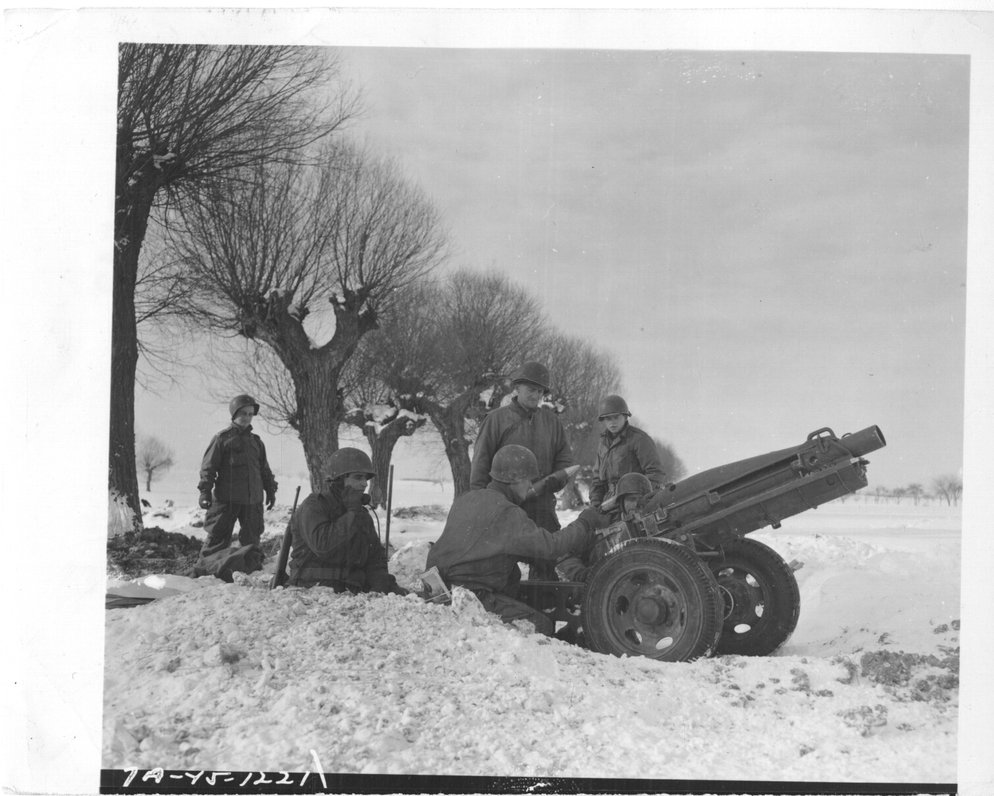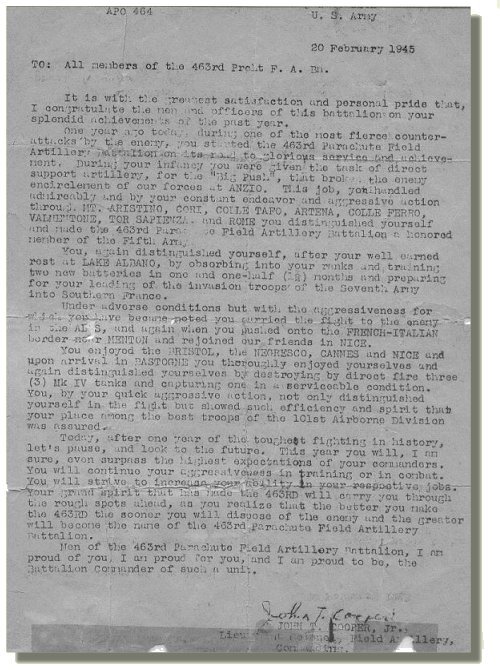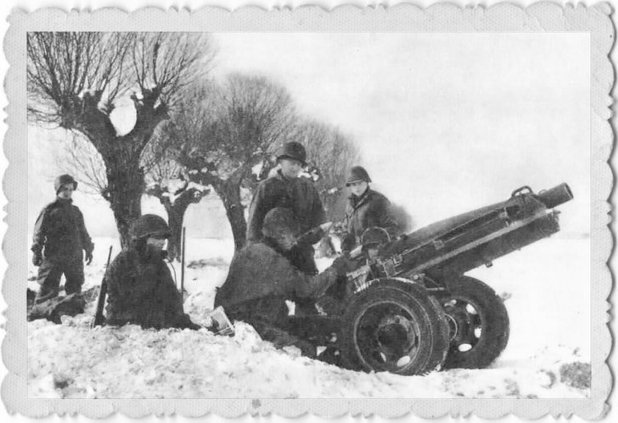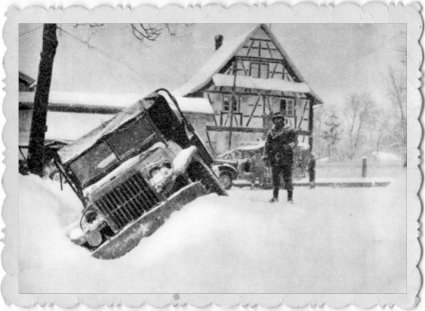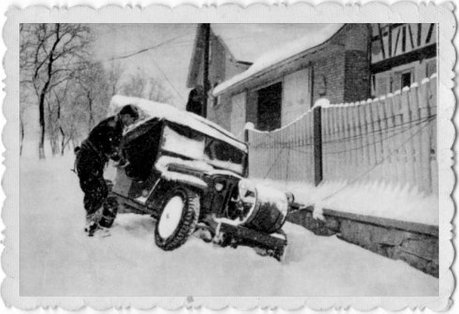The (Bastogne to) Alsace Campaign (France)
January 15 - January 27, 1945 (Bastogne to the Alsace)
January 27 - February 25, 1945 (the Alsace Campaign)
Credit
A lot of gratitude towards WW2 D Battery Mr. Ken HESLER for research and writing.
Resource materials for the Alsace campaign, along with the encampment that followed at Tent City in Mourmelon le Petit, are the official 463rd operational records and “Rendezvous With Destiny: A History of the 101st Airborne Division” by Leonard Rapport and Arthur Northwood, Jr., published in 1948 by the 101st Airborne Division Association. Inasmuch as the 463rd was not in combat during the March 1945 stay in Mourmelon, “Rendezvous With Destiny" is the principal source of information for that period.
From Bastogne to the Alsace
The 463rd Parachute Field Artillery Battalion left its Hemroulle station January 15, 1945, and moved about four miles to near Foy following the infantry advance to the northeast.
As the 327th Glider Infantry Regiment, supported by the 463rd, continued to advance despite enemy counterattacks and infiltrations, the battalion moved forward. On the 16th, a battalion pilot, 1st Lt. George W. Schoeneck of Arkansas, and his air observer, 2nd Lt. Jack S. Terry of Georgia, were KIA during an air operation seeking enemy targets. According to George Koskimaki’s “Battered Bastards of Bastogne,” “...their plane ran into the path of a friendly artillery shell....”
The 463rd’s Bastogne campaign came to a close when it was relieved near Sibret on the 17th by the 11th Armored Division. It then traveled on the following day in two separate groups to Lineville and Wideûmont, Belgium, in preparation for the movement of the 101st to the Seventh Army front in Alsace where the Germans had counter-attacked to cutoff the city of Strasbourg.
The main body of the 101st began its move to Alsace January 20. As told in "Rendezvous With Destiny":
In addition to the vehicles of the 463rd, the convoy included "112 10-ton and 98 2 ½-ton trucks furnished by VIII Corps and Third Army."
Many 463rd troops rode in the 10-ton vehicles with truck beds covered with straw and tarpaulin stretched flat overhead for protection from the elements, with room only to sit or lie down.
“The trip was to be long — about thirty-six hours — and the weather as cold and miserable as any encountered during the fighting . . . All the way to Alsace the roads were slippery and dangerous, and falling snow kept speeds down. The men settled down in the trucks, bundled as well as they could, and saw the Bastogne countryside fall behind.” (“Rendezvous With Destiny,” p. 665.) The battalion’s first stop was Lixheim, France.
"On the 24th both the 463rd and the 377th Parachute Field Artillery Battalions dragged their guns into position near Saint-Louis-lès-Bitche only to drag them back again later in the day... The artillerymen were not too pleased at having to haul their guns up two hills where it took two jeeps to move one 75mm howitzer, dig them in in the frozen ground, and then get the ‘close station, march’ order.” (“Rendezvous With Destiny,” p. 669.)
After a brief stay in Lixheim, the battalion went into position in Keffendorf, France January 27, in the vicinity of Haguenau.
Historical Narrative for the Alsace Campaign
On 1 February 1945 the 463rd Parachute Field Artillery Battalion with its command post in the town of Keffendorf, France (9500-2221 from sheet 38/14, Haguenau) and occupying the position as indicated on overlay "A", was firing in support of the 327th Glider Infantry Regiment operating in the Neubourg (9590-2675 sheet 38/14 Haguenau) sector of France with the front lines generally along the Moder River.
Also on 1 February 1945 the 79th Division staged a limited attack and being called upon to assist in the support of this mission this battalion fired preparation fires from 2020 hour to 2345 hour. This organization continued its normal firing, consisting of numerous harassing, intradictory and targets of opportunity missions.
In addition to the normal observation posts, on 10 February 1945 the battalion established a battalion observation post for the purpose of directing the fire of a reinforcing medium artillery battalion. From the observation post established, excellent observation on enemy rear areas was available. Through this observation post it was possible to bring medium artillery fire to bear on the enemy's supply installations and denied him the use of the vital supply road nets.
Due to the maneuver of friendly infantry, and in order to deliver supporting fire for the 327th Glider infantry Regiment, a displacement was necessary and after reconnaissance on 11 February 1945 this battalion executed its displacement, closing into its new position at 2000 hour 12 February 1945 with the Battalion command post established in the town of Winterhouse, France (9755-2160 sheet 38/14 Haguenau).
Operation in the supported Infantry's sector was normal until 14 February 1945 when the enemy struck with an attack from 2000 hours to 2215 hours. During this attack prearranged defensive fires were brought to bear on the enemy, counter preparation missions fired and the attack was successfully repelled.
The enemy again at about 2200 hour 18 February 1945 staged an attack, this time only of approximate patrol strength. This patrol action was accompanied by a fire demonstration but the complete enemy effort was counteracted by effective fires of this battalion, reinforced by Division Artillery, the 242nd Field Artillery Battalion and VI Corps counterbattery. The apparent results of this fire was that the enemy machine guns, mortars and rocket projectors were effectively silenced and an ammunition dump was set afire and continued to burn and explode for several hours.
This battalion remained in the same location and continued its fire in support of the 327th Glider Infantry Regiment until officially relieved by the 36th Division Artillery at 2000 hour 25 February 1945.
A Condensed Chronology, by Martin GRAHAM
Based in large part on a collection of archival documents and other materials,
acquired and provided by Ken Hesler, Battery D, 463rd PFA.
DATE OF ARRIVAL | DESTINATION | MODE OF TRAVEL
January 1945
Jan. 20 | Truck | Sibret, Belgium
Arrived at 2PM
Jan. 20 | Truck | Drulingen, Lorraine
Arrived at 11PM
Moves:
Truck Neufchateau, Belgium
Truck Tintigny, Belgium
Truck Belle Fontaine, Belgium*
Truck Virton, Belgium
Truck Longuyon, France
Truck Spincourt, France
Truck Etain, France
Truck Fresnes (en Woëvre), France
Truck Vigneulles, France
Truck Gironville, France
Truck Jovy, France*
Truck Gondreville, France*
Truck Nancy, France
Truck Laneuvelotte, France*
Truck Lesley, France*
Truck Bourdonnay, France
Truck Héming, France
Jan. 21 | Truck | Lixheim, France
Arrived 2200 hours.
Jan. 24 | Truck | Sarrebourg, France
Move:
Truck Saverne, France
Jan. 24 | Truck | Saint-Louis-lès-Bitche, France
"Both the 463rd and 377th Parachute Field Artillery Battalions dragged their guns into position only to close stations and drag them back again later in the day." (Rendezvous with Destiny)
Jan. 26 | Truck | Keffendorf, France
Arrived 1800 hour. Fired in direct support of 327th.
Jan. 31 | Keffendorf, France
Monthly Report - Fired 14,072 rounds on: Personnel - 100; Strongpoint - 3; Tanks - 44; Mortars - 12; GPs -7; OPs - 2; Halftracks - 6; MG's - 8; SPs - 2.
Received orders to join the 17th Airborne Division, but General Maxwell Taylor interceded, stating "the 463rd is firmly united with this Division and any change will result in serious loss of morale and efficiency both to the Division and to the Battalion."
Officers Enlisted
Hq & Hq Btry 18 159
A 4 88
B 3 82
C 4 88
D 3 87
Met Det 2 13
TOTAL 33 517
February 1945
Artillerymen of a paratrooper battalion prepare to fire 75mm pack howitzer
in snow-covered position near Haguenau, France.
463rd Para Bn. 12 Feb 1945.
Courtesy National Archives,
photo no. 111SC-360950
(click to enlarge)
Feb. 1
Assisted in support of attack by 79th Division.
Feb. 7
Casualties:
Sgt. Clifford Wolfenbarger WIA
Tec 4 Russell Hughes WIA
Pvt. Edward E. Helm WIA
Feb. 12 | Truck | Wintershouse, France
Arrived 2000 hours. Helped repell enemy attack.
Feb. 18
Helped repell enemy attack.
Feb. 20
John Cooper - Message to men from John T. Cooper, Jr., Lt. Col., Field Artillery, Commanding Officer:
It is with the greatest satisfaction and personal pride that I congratulate the men and officers of this battalion on your splendid achievements of the past year.
One year ago today, during one of the most fierce counter-attacks by the enemy, you started the 463rd Parachute Field Artillery Battalion on its road to glorious service and achievement. During your infancy you were given the task of direct support artillery, for the "Big Push", that broke the enemy encirclement of our forces at ANZIO. This job, you handled admirably and by your constant endeavor and aggressive action through MT. ARISTINO, CORI, COLLE TAFO, ARTENA, COLLE FERRO, VALMONTONE, TOR SAPIENZA, and ROME you distinguished yourself and made the 463rd Parachute Field Artillery Battalion a honored member of the Fifth Army.
You, again distinguished yourself, after your well earned rest at LAKE ALBANO, by absorbing into your ranks and training two new batteries in one and one-half (11/2) months and preparing for your leading of the invasion troops of the Seventh Army into Southern France.
Under adverse conditions but with aggressiveness for which you have become noted you carried the fight to the enemy in the ALPS, and again when you pushed onto the FRENCH-ITALIAN border near MENTON and rejoined our friends in NICE.
You enjoyed the BRISTOL, the NEGRESCO, CANNES and NICE and upon arrival in BASTOGNE you thoroughly enjoyed yourselves and again distinguished yourselves by destroying by direct fire three (3) Mk IV Tanks and capturing one in a serviceable condition. You, by your quick aggressive action, not only distinguished yourself in the fight but showed such efficiency and spirit that your place among the best troops of the 101st Airborne Division was assured.
Today, after one year of the toughest fighting in history, let's pause, and look to the future. This year you will, I am sure, even surpass the highest expectations of your commanders. Your will continue your aggressiveness in training or in combat. You will strive to increase your ability in your respective jobs. Your grand spirit that has made the 463RD will carry you through the rough spots ahead, as you realize that the better you make the 463rd the sooner you will dispose of the enemy and the greater will become the name of the 463rd Parachute Field Artillery Battalion.
Men of the 463rd Parachute Field Artillery Battalion, I am proud of you, I am proud for you, and I am proud to be the Battalion Commander of such a unit.
Monthly Report
Fired 7,029 rounds on: Personnel - 136; GPs - 9; Mortars - 45; MG's - 42; Vehicles - 16; Armor - 16; Ammunition dumps - 1; OPs - 1.
Officers Enlisted
Hq & Hq Btry 17 160
A 4 85
B 4 84
C 4 91
D 4 88
Met Det 2 13
TOTAL 35 521
Feb. 28 | Wintershouse, France
Moves:
Truck Toul, France
Truck Ligny (-en-Barrois), France
Truck Châlons, France
What the reports say
March 12, 1945 | LTC John T. Cooper
SUBJECT: Transmittal of Historical Records.
TO : Commanding General, 101st Airborne Division, APO 472,
US Army (Attention: Assistant Chief of Staff (G-3).
1. Transmitted herewith is Historical Records of this Battalion for the period 1 February 1945 to 25 February 1945 inclusive.
2. Conclusion and critique:
Operating in this comparatively quite sector enabled the Battalion to continue its experiment of Panoramic Photographs and Aerial Photographs with the use of a Cub Plane.
It was found that unless the forward observation post was located well forward, the grafex camera without telescopic lens would not produce a picture with enough detail to be used. From another forward observation post located within 500 yards of the front lines the grafex camera with the standard equipped lens made a very good panoramic photograph. Pictures can be made and processed within a twenty four hour period. The slowest procedure is the improvised methods of drying the negatives and prints.
Due to bad weather we were unable to do enough work from the plane to definitely make any conclusion as to advisability of attempting to make aerial photographs.
It must be kept in mind that this experiment is in no way intended to try to give the coverage and exactness that is expected of the Air Corps with their specialized equipment. Our experiment is to include and try to utilize only the equipment that can usually be found within any battalion.
Upon being relieved on the 25 day of February the Battalion moved by rail and organic transportation to Mourmelon, France. Due to the long moves and continued operations I am of the opinion that Airborne Troops should be organized and equipped as a ground infantry division and given such extra airborne equipment as is needed when it becomes necessary.
Pictures
Ken Hesler : "A scene in the Fire Direction Center in Alsace (Winterhouse).
In the photo, I am the third from the left.
I knew the others in the photo a relatively short time and do not recall their names although they all look familiar.
They are from the other batteries.
Each of us handled phones to the respective batteries during fire missions.
Maj. Vic Garrett was in charge of the operation.
You can see we were playing cards during a lull in activity."
Ken Hesler: "I cannot identify any unit associated with this gun section,
but the view is typical for Alsace.
As to the building in the two photos below, I have always thought but cannot confirm
that it is either the same or looks exactly like the quarters
in which I stayed when assigned to Fire Direction Center at Winterhouse."
NOTE: according to the later received picture by NARA (see above) this was captioned 463rd Para Field Arty.
The photographs above right and below are from the Alsace section of "Epic of the 101st Airborne," a picture book produced and distributed by the Division at war's end."
Ken Hesler: "My living area was on the second floor at right (two-pane window)
directly over what was a battery or battalion office below.
I never went there, only going back and forth to the FDC located in a nearby school building."
The page caption for the two photos of the same building is as follows:
"The charming half-timbered homes and the comparative quiet of the Alsace-Lorraine countryside
was welcome after the vicious Belgium campaign.
For the first time in over a month most of the troops were quartered indoors,
and when the division finally settled into defensive positions in Haguenau on the Moder River,
even many of the men on the line had shelter."







